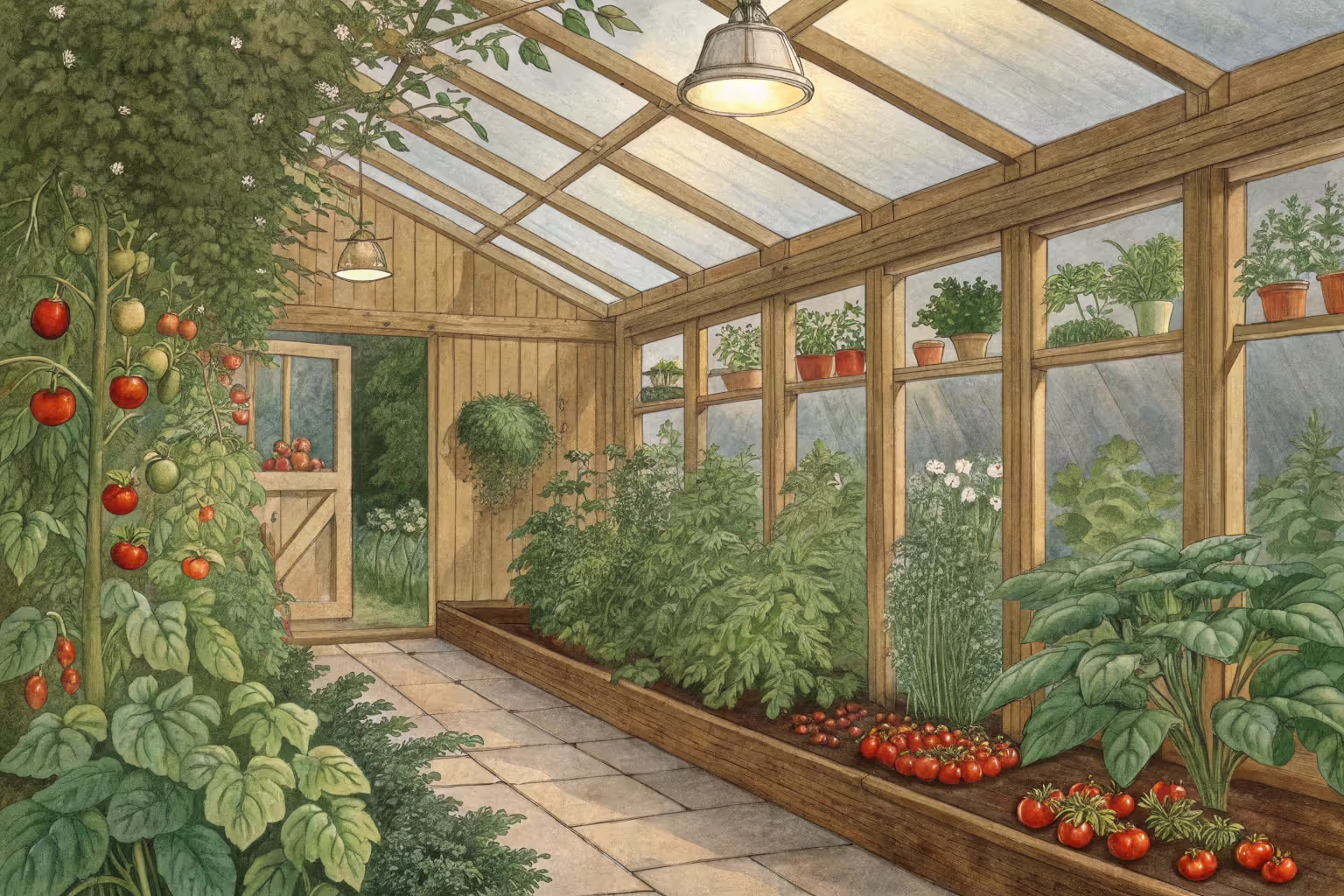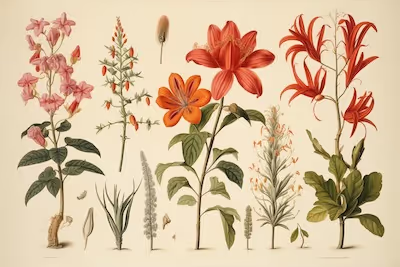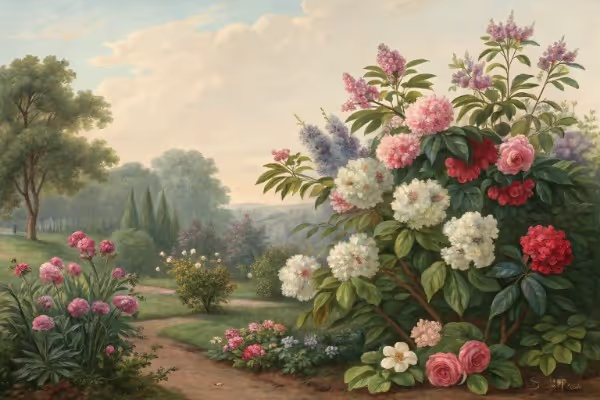How Do You Grow Food Indoors?

Growing food indoors
Growing food indoors puts fresh produce within easy reach, no matter the season. With quality grow lights, adequate airflow, and mindful watering, growing food indoors lets you harvest vibrant herbs and crisp greens from your own kitchen. Ready to transform your countertop into an edible oasis? Here's how to get started.
Cheatsheet: Indoor Food Gardening Essentials
🌱 Best Crops for Indoors
- Leafy greens: Lettuce, spinach, kale
- Herbs: Basil, parsley, chives, mint
- Fruit/veg: Tomatoes (dwarf), peppers, radishes, microgreens
🔆 Light Requirements
South-facing windows work best. Most crops need 12-16 hrs of light. LED grow lights (full spectrum) fill gaps. Place plants 6-12 in / 15-30 cm below lights.
💧 Water & Humidity
Water when surface is dry. Avoid soggy soil. Aim for 40-60% humidity. Use trays of water or pebble trays for extra moisture.
🌡️ Temperature & Airflow
Target 65-75°F / 18-24°C. Avoid drafts and heat sources. Use a fan for gentle airflow to prevent mold.
🪴 Potting & Soil
- Use sterile, organic potting mix
- Ensure pots have drainage holes
- Fertilize every 2-4 weeks with liquid feed
🏆 Freshness & Nutrition
Indoor-gardeners enjoy fresh, pesticide-free produce. Homegrown herbs are up to 3x more flavorful. Microgreens can contain 40x nutrients of mature greens.
🛠️ Tools and Products You'll Need
- Grow lights (LED, full spectrum)
- Containers with drainage
- Organic potting mix
- Seeds or seedlings
- Fan (optional, for airflow)
- Watering can or spray bottle
- Liquid fertilizer
- Humidity tray (optional)
- Timer for lights
👣 Steps to Get Started
- Choose crops matched to your indoor light.
- Fill containers with potting mix; moisten soil.
- Sow seeds or transplant seedlings.
- Set under grow lights or near bright window.
- Water when soil surface dries out.
- Add fertilizer every 2-4 weeks.
- Harvest leaves or fruit when mature.
Growing food indoors: a field guide from the kitchen table
I started on a window ledge with a shop light and a basil plant that refused to quit. The lessons stuck, and the harvests grew.
Light is food
Photosynthetic photon flux density (PPFD) tells you how many light particles hit a leaf each second, which is what plants actually use. For leafy greens, aim for 200 to 300 µmol per square meter per second, and for fruiting crops like tomatoes, aim for 600 to 800.
Daily light integral (DLI) sums those photons across the day. Lettuce thrives around 12 to 17 mol per square meter per day while peppers want 20 to 30.
“Plants don’t see lumens, they see photons.” Dr. Bruce Bugbee, Utah State University
Run lights 14 to 18 hours for greens and 12 to 14 for fruiting crops. I give basil 16 hours, then dial back to 14 once it’s bushy.
Picking a grow light that actually feeds plants
- Choose a full-spectrum LED around 3500 to 4000 K for mixed crops or 5000 K for leafy greens.
- Look for efficacy near 2.5 to 3.0 µmol per joule for lower power bills and less heat.
- Bar-style fixtures spread light evenly on shelves, while boards suit 2 by 2 ft spaces.
- Hang distance matters: I start at 12 to 18 in and adjust so leaves sit at the target PPFD.
- A cheap lux meter plus a conversion chart gets you in the ballpark for PPFD on greens.
Heat rises fast in small rooms. I like lights with dimmers, which let me tune intensity without roasting the parsley.
Temperature, humidity, airflow
Most edibles cruise at 68 to 75 F or 20 to 24 C by day and 60 to 65 F or 15 to 18 C at night. Leafy greens like it on the cool side, while basil sulks below 60 F or 15 C.
Keep relative humidity near 45 to 55 percent to match a cozy home and happy stomata. A small clip fan moves air gently and keeps diseases from getting cozy.
Vapor pressure deficit (VPD) sounds technical, but it’s the balance between humidity and temperature that sets plant thirst. If leaves curl and edges crisp, humidity is too low for the heat in the room.
Soil, soilless, or water culture
A high quality peat-free mix with perlite or pumice drains fast and stays airy. I blend 60 percent coco coir, 30 percent composted bark, 10 percent perlite, then add a slow-release organic fertilizer.
Hydroponics trades soil for water and nutrients. It pays in speed for greens if you manage pH and electrical conductivity.
In hydro I target pH 5.8 to 6.2 and EC 1.2 to 1.8 mS per cm for greens, up to 2.2 for fruiting crops. A simple pen meter stops guesswork.
Water quality matters more indoors
Hard tap water can lock up iron and calcium. If total dissolved solids top 200 ppm, consider a calcium magnesium supplement or dilute with filtered water.
I let tap water sit overnight to off-gas chlorine, then adjust pH. Little habits prevent big problems.
What actually grows best inside
- Cut-and-come-again lettuce, arugula, mustards, baby kale
- Basil, mint, chives, cilantro, parsley, thyme
- Scallions from supermarket roots that regrow for months
- Dwarf tomatoes and peppers bred for containers
- Bush cucumbers and day-neutral strawberries for racks with height
- Pea shoots, sunflower shoots, and microgreens for fast wins
- Mushrooms in kits for dark corners away from the greens
Top picks for Growing food indoors, by goal
- Fastest calories: microgreens in 7 to 12 days, 4 to 8 oz per 10 by 20 in tray.
- Most flavor per square foot: basil, cilantro, thyme under 200 to 300 PPFD.
- Family salad bar: three trays of mixed lettuce, staggered weekly.
- Snack vines: dwarf tomato on a trellised shelf with 600 PPFD and a fan.
- Low effort: scallions in jars and mint in a wide pot that never dries out.
My shelf setup that pays for itself
One 4 tier wire rack, two LED bars per shelf, trays on boot mats to catch spills. The bottom shelf holds a tote for hydro lettuce with an air stone.
I run a small oscillating fan on low and a timer for lights. A hygrometer sits at leaf height so I read what plants feel, not the floor.
Planting schedule that keeps plates full
- Sow 1 tray of micros every 4 days.
- Sow 1 tray of cut lettuce every 7 days for 4 weeks, then repeat.
- Start a dwarf tomato every 8 to 10 weeks if you want continuous fruit.
- Refresh basil every 6 weeks to dodge woody stems and slow regrowth.
Pollination and pruning inside four walls
Tomatoes and peppers self-pollinate if flowers vibrate. I tap stems daily or use an electric toothbrush on the truss.
Prune lower leaves to open the canopy and cut suckers on tomatoes for better airflow. A lean plant minds pests less.
Feeding schedules that don’t guess
In containers I add a light liquid feed once a week at one quarter to one half label rate. Leaves tell the truth: pale new growth wants nitrogen and iron while brown edges ask for potassium and calcium.
In hydro I change solution every 10 to 14 days and top off with plain water between changes. Keep notes, because your system becomes your recipe book.
Common indoor pests and the fast fixes
- Fungus gnats: bottom water less, let the top 2 cm dry, and add BTI bits to water.
- Aphids: spray with insecticidal soap, repeat in 3 days, then release lacewing larvae if they persist.
- Thrips: blue sticky cards and a weekly neem oil rotation, plus a fan.
- Powdery mildew on basil: increase airflow, trim for light penetration, and avoid evening misting.
Quarantine new plants for 10 days away from your main rack. One infested basil can seed a population fast.
Food safety inside the house
Sanitize trays with a 10 percent bleach rinse or 70 percent isopropyl, then air dry. Keep potting mixes off kitchen counters and wash greens.
Raw sprouts carry a higher risk of pathogens, as the FDA reminds growers. I use sanitized seed and clean gear, and I cook mung bean sprouts for stir fries.
Costs, yield, and the honest math
A 100 watt LED for 16 hours uses 1.6 kWh per day. At 0.15 dollars per kWh that is about 0.24 dollars per day, or roughly 7.20 dollars per month, while at 0.20 euros per kWh it is about 0.32 euros per day.
My two-shelf salad setup grows about 1 to 1.5 lb or 450 to 700 g of greens weekly. That covers the energy bill and tastes like a Friday market in January.
Quick-start recipe for the first win
- Set a 2 by 4 ft shelf with two 100 watt LEDs at 12 in above trays.
- Fill two 10 by 20 in trays with peat-free mix, sow a dense lettuce mix, and cover lightly.
- Water to field capacity, then bottom water only when trays lighten.
- Run lights 16 hours, keep room at 70 F or 21 C, and snip in 21 to 28 days.
Hydro methods that work in apartments
- Kratky: static reservoir, lettuce heads in 30 days, no pumps.
- DWC: one tote, one air pump, and greens that leap out of the net pots.
- NFT: channels for fast turnover of baby greens if you want production.
I start growers on Kratky to learn nutrient rhythms. The roots teach you more than a manual.
Space, reflection, and noise
Line the back of the rack with mylar or a white board to bounce light. Keep pumps on foam pads to cut vibration that travels through floors.
Shelves like 14 to 18 in clearance per tier make life easier. Tall peppers need the top deck with room to breathe.
Commercial questions I hear all the time
- Which light size: cover your footprint at 30 to 40 watts per square foot for fruiting crops, 15 to 25 for greens.
- Which spectrum: full spectrum 3500 to 4000 K for mixed grows, 5000 K for leafy-only racks.
- Which meter: a basic pH and EC pen beats guessing and pays back quickly.
- Which tent: use a 2 by 4 ft or 3 by 3 ft if you need light containment and odor control for herbs like basil.
- Which fan: any quiet clip fan that sweeps the canopy without fluttering leaves wildly.
Troubleshooting fast
- Leggy seedlings: increase light intensity or lower the fixture a few inches.
- Tip burn on lettuce: lower EC, raise airflow, and keep temps near 68 F or 20 C.
- Blossom drop on tomatoes: raise PPFD to 600 plus, keep nights above 60 F or 15 C, and add a fan.
- Yellow new leaves with green veins: likely iron lockout from high pH, so adjust down to near 6.0.
- Bitter greens: cooler temps and faster growth fix flavor.
Why indoor herbs taste bigger than their size
Stress nudges plants to produce more aromatic oils, which is why a sunny, dry shelf makes thyme sing. I water basil deeply, then let the top 2 cm dry to coax flavor.
Curiosities that surprised me
Mint grown under 5000 K tastes brighter than under 3000 K in blind tastings at my house. Strawberries set fruit fine with an electric toothbrush and a fan, even two rooms from a window.
What research and institutions say
NASA’s plant labs showed LEDs grow lettuce and zinnias in space; light quality and intensity are the levers. Controlled environment agriculture scaled those lessons for homes and greenhouses.
Cornell Cooperative Extension advises 12 to 16 hours of light for seedlings and cool temps to avoid legginess. UC Davis notes that calcium deficiency shows as tip burn on fast-grown lettuce in warm, still air, which mirrors what indoor racks see.
FDA guidance flags raw sprout safety; sanitize and consider cooking. The Royal Horticultural Society reminds growers that consistent watering reduces bitter compounds in leafy greens.
One last pattern I trust
Plants reward routine. Same light time, same airflow, same watering window, and they settle in.
I grow like a good kitchen: prep, mise en place, and a clean station. The harvest follows.

Want smarter plant choices? 🪴
Indoor Gardening FAQs: What You Really Need to Know
What edible plants thrive indoors?
Herbs like basil, mint, parsley, and cilantro soak up indoor conditions like a summer afternoon. Greens such as arugula, kale, spinach, and lettuce flourish under modest artificial light, making them ideal indoor residents. Even cherry tomatoes and chili peppers can thrive if you provide ample sunlight or vigorous grow lights.
How do you ensure your indoor crops are getting enough light?
Natural sunlight through south-facing windows is perfection, but for shadowy urban apartments, LED grow lights spark growth remarkably well. Place them just a few inches above your plants, mirroring natural daylight cycles—around 14–16 hours of illumination per day—offering them a rhythm of rest and peak photosynthesis.
What is the ideal setup for watering indoor food-producing plants?
Avoid the drowning waters of overly generous hands. Employ pots with drainage holes and a well-aerated soil medium. Allow the topsoil to feel slightly dry between waterings, and then provide a substantial but gentle soak. Maintaining steady moisture—free from waterlogging—is vital for healthy plant roots and vibrant growth indoors.
Can you realistically harvest vegetables indoors without pests taking over?
With vigilance, yes. Regularly inspect your indoor garden's leaves and stems. At the slightest hint of aphids or fungus gnats, employ organic solutions like neem oil or insecticidal soap sprays. Keeping humidity moderate with good air circulation discourages pest colonies from making your edible garden their home.
Do indoor vegetable plants need additional nutrients?
Your indoor veggies depend entirely on you to deliver nutrients. Feed them regularly with a balanced, water-soluble organic fertilizer—monthly or according to brand recommendations—since potted soil quickly depletes essential minerals. This approach sustains vigorous, fruitful plants without compromising taste or quality.
Are hydroponic systems worth considering inside an apartment?
Absolutely. Hydroponics lets urban gardeners produce vigorous greens, herbs, strawberries, and more without dealing with soil-related messes. These compact water-based systems economize space and accelerate growth, often yielding faster harvests. It's a compelling way to cultivate fresh produce indoors, especially when space is scarce.
Growing food indoors strips gardening down to its essentials: fresh light, good soil, and a bit of patience. Pick compact crops—herbs, leafy greens, maybe a dwarf tomato. Give them what they crave: steady moisture, airflow, and a window or grow light that doesn’t quit. Keep an eye out for trouble—fungus loves humid corners, so simple tricks like using cinnamon powder on seedlings can save you headaches. Fertilizer matters, too; even your leftover cooking liquids can feed a hungry plant. With a little grit and some trial and error, you’ll find a rhythm. Fresh food in arm’s reach—no backyard required. That’s the real flavor of growing food indoors.
Pro Tips for Maximizing Indoor Food Production
Optimal Lighting Strategies
- Position plants 6-12 inches (15-30 cm) from grow lights for leafy greens; 18-24 inches (45-60 cm) for fruiting crops.
- Maintain a consistent photoperiod: 14-16 hours daily for vegetables, 10-12 hours daily for herbs.
- Increase productivity up to 40% by combining red (660nm) and blue (450nm) spectrum LEDs.
Air Quality and Flow Management
- Improve plant vigor by circulating air gently at 1-2 mph (1.6-3.2 kph) using small oscillating fans.
- Reduce mold risk by maintaining relative humidity below 60%.
- Boost plant growth rates by supplementing carbon dioxide (CO₂) to 800-1200 ppm during daylight hours.
Soil-Free Techniques for Increased Yield
- Grow leafy greens via hydroponic systems to achieve yields up to 50% greater than traditional methods.
- Use coir or perlite-based substrates in container gardening to enhance aeration and nutrient absorption.
- Adjust hydroponic nutrient solution pH regularly to maintain optimal levels: approximately 5.8-6.2.
Boosting Nutrition and Flavor
- Strengthen antioxidants and flavor intensity by slightly stressing herbs with moderate nutrient reduction.
- Harvest leafy greens early morning (within first hour of photoperiod) to maximize nutrient density.
- Include microgreens—often containing up to 40 times more nutrients per gram than mature counterparts—to enhance dietary benefits.
Energy and Sustainability Practices
- Cut energy consumption by scheduling grow lights during off-peak electricity hours.
- Reuse nutrient-rich hydroponic wastewater for ornamental houseplants or garden beds.
- Compost excess plant material indoors with worm composting bins to generate nutrient-dense fertilizer.
Find out which plants will thrive in your garden!
Answer a few fun questions and get custom plant recommendations perfect for your space. Let’s grow something amazing together!

start your season


.avif)


